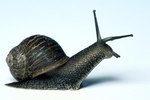
The term snail is a common name applied to any gastropod mollusk who can retract into his shell. Thousands of species of snails live on land, in freshwater streams and ponds, and in saltwater bodies. They inhabit a range of regions including arid deserts and frigid sea depths.
Shell Adaptations

Snails' shells protect them from predators and the elements, and different snails have different adaptations, depending upon the regions they inhabit. Cone snails, for example, have evolved to sport large, cone-shaped shells that help them burrow into ocean sand. Additionally, the shape of the shell makes it difficult for crabs -- cone snails' natural enemies -- to grasp their slanted lengths. Other adaptations are shell patterns that serve as camouflage and shell thickness that preserves moisture.
Breathing Apparatus

Freshwater and marine snails have evolved gills, while terrestrial snails sport fully formed lungs. Golden apple snails have adapted by possessing both a lung and gills. They can absorb oxygen straight from the water or siphon air through a tube on the left side of the body. This adaptation means they can travel from water source to water source and can survive in polluted aquatic environments. Their ability to directly breathe allows them to lay their eggs outside of water and away from hungry fish.
Hibernation and Estivation

Hibernation in snails is an adaptation that serves a multitude of purposes. Snails in areas prone to frost or freezing temperatures will hibernate during winters. Alternatively, snails inhabiting dry, arid regions will estivate -- a summer version of hibernation -- when water is scarce or when droughts occur. In both situations, by secreting extra mucus and sealing themselves into their shells, snails protect themselves with trapped humidity and filtered oxygen. During this time, metabolism slows and the snails live in a suspended state until warm rains revive them.
Secretions

The slime that snails secrete is more than a silvery trail left on the front doorstep; this mucus is an adaptation that helps terrestrial snails survive out of water. Snails' slime is naturally hygroscopic, meaning that, instead of releasing water, it attracts it. This helps snails stay damp throughout the day and assists in movement, reproduction and breathing. Snails secrete more than simply slime; cone snails can release drops of a sedativelike chemical into the water around them, effectively calming the fish in their environment enough to hunt and kill them.
Body Adaptations

Snails' fascinating bodies are capable of incredible change and adaptation. The eyes of water-dwelling and land snails have adapted to perch on two eye stalks that can retract and extend from the snails' bodies. These eye stalks slip inside-out when retracting, protecting the snails' eyesight from predators, turf wars and the elements. Snail bodies have adapted for reproduction; snails are hermaphroditic -- they can change sex if necessary to procreate. In addition to their ability to change sex, some snails can self-fertilize and reproduce asexually.
References
- Cone Snail: Venom
- University of Wisconsin: Snail Adaptation
- Population Analyses, Variation and Behavior of Anguispira Alternata; C.L. Douglas
- Living World of Molluscs: Adaptations in Terrestrial Snails
- Gireaud: Snail Hibernation
- Relative Size Influences Gender Role in the Freshwater Hermaphroditic Snail, Helisoma Trivolvis; Cynthia G. Norton et al.
- Sea World: Marine Snails
Resources
Photo Credits
-
Razmaz/Lifesize/Getty Images




